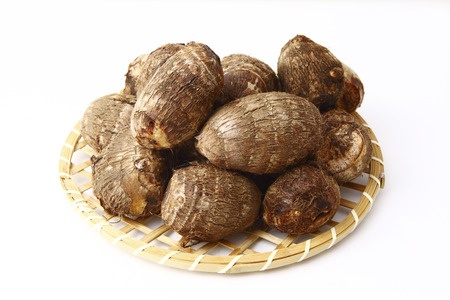
Taro (Colocasia esculenta L. Shott) is a tropical root vegetable that is widely eaten across the globe. It has a rich multicultural history of consumption having found its way into a number of recipes. The plant is grown in semi-tropical and tropical climates all over the world.
The roots are also suitable for drying which makes it an excellent crop during times of famine. It’s quite versatile too – the leaves of the taro plant are also eaten.
Nutritional Benefits
Nutritionally, taro has a high starch content (especially resistant starch) which puts it on a par with potato but its value as a staple is that it can be digested so easily. This latter property is due to the way the starch granules are constructed in the root.
Taro root contains over 6 grams of fiber per cup (132 grams). This is nearly three times the dietary fibre content of the equivalent amount of potato. Fibre is a key nutrient for good digestive health and regularity. There is a substantial amount of resistant starch which is a key insoluble fibre with its own specific benefits for gut health (Higgins, 2004). Resistant starches are known to reduce blood cholesterol levels and is also linked to reducing the risk of cardiovascular disease. Fibre also helps make you feel full and so makes you feel less hungry with fewer calories.
Taro root has a relatively low glycemic index, as opposed to potato which has a high glycemic index. A low GI means that taro causes blood sugar levels to rise more slowly, without the peaks and crashes of a high GI, which can produce increased hunger pangs later on. Incidentally, eating a diet of low GI foods can also help prevent diabetes.
The calorific content is 143 kcal per 100 grams compared to 95 kcal for potatoes. It appears to be much more calorie rich and that may be due to its higher starch availability.
So, not only are the roots great on energy content but they contain various B vitamins, calcium, copper, phosphorous and iron. For example, taro roots contain a quarter of our RDA (Recommended Daily Amount) of vitamin B6 (pyridoxamine). This vitamin is essential for the proper metabolism of food stuffs to generate energy, the manufacture of proteins as required in the production of muscle, for growth and general recovery.
It is also non-allergenic.
The leaves are valuable sources of vitamin A and vitamin C which means that the plant has quite a healthy all encompassing value.
Potential For Reducing The Risk Of Cardiovascular Disease/Heart Disease
Taro roots contain high quantities of fibre and in particular resistant starch.
Fibre consumption is strongly linked to reducing the risk of heart disease (Threapleton et al., 2013). It is well known that people who eat plenty of fibre, both insoluble and soluble, have lower levels of heart disease. A much earlier study, the Zutphen Study (Streppel et al., 2008) showed that simple increases in level of fibre consumption, say 10g of fibre per day, also helped raise the level of mortality or rather cut the death rate.
Potential In Diabetes Management
Taro consumption does not specifically reduce diabetes but the fact that it contains plenty of resistant starch makes it a valuable food for those using dietary methods in managing both pre-diabetic and diabetic states (Marlatt et al., 2018). High level of dietary fibre help to iron out the highs and lows that occur in blood sugar levels when we suffer with diabetes (Anderson & Bryant, 1986).
Taro And Weight Loss
Consumption of high fibre foods is also associated with effective weight management especially where fat reduction is needed. There is plenty of evidence to show that a diet high in fibre which might include taro root would help with dieting (Slavin, 2005). The presence of resistant starch should help considerably because a variety of studies have indicated how this fibre helps in weight reduction especially with the metabolism or burning up of fat.
Taro Consumption And Cancer Management
The consumption of taro is not directly linked to curing cancer, however, there are a number of antioxidant compounds in the root which help with mopping up free radicals as well as having our good friend dietary fibre.
High levels of both vitamin A and C along with various phenolic compounds have been shown to eliminate free radicals from our body which are implicated in causing cancerous cells to form. One molecule which is not found in many other plants but is in taro called cryptoxanthin is associated with reducing the incidence of particular cancers of the lungs and mouth (WCRF & AICR)
Taro And Immunomodulatory Activity
Taro might have components in it which would help those with immunocompromised diseases or require bolstering of their immune system.
Two novel non-starch polysaccharides have been extracted from taro called TPS-1 and TPS-2 which are composed of rhamnose, xylose, glucose and galactose (Li et al., 2018).
The polysaccharide TPS-2 showed a higher immunomodulatory activity than TPS-1 in a cell line study. TPS-2 promoted the generation of NO, TNF-α, and IL-6 production in RAW 264.7 cells. TPS-2 also appeared to help macrophages perform their function of destroying harmful cells through phagocytosis.
The possible implication here is that Colocasia’s unique carbohydrates serve as novel and potential immunostimulants for the food and pharmaceutical industries especially for those with poor and immunocompromised patients.
Issues With Consumption Of Taro
One of the issues though is the presence of an acrid factor which causes irritation of the various membranes such as mouth and tongue. This only occurs if the tuber is eaten raw or only partially cooked although to be frank it would be virtually inedible. That acrid factor is calcium oxalate which is found in other plants like rhubarb leaves and some house plants. It could also be an issue for those having gall stones, gout or kidney stones but adding sodium bicarbonate ameliorates the situation during cooking too.
In Hawaii, one variety called Lehua Maoli is used for making ‘poi’ which has one of the highest oxalate contents known. However, another variety called Bun-long which produces a large corm is very low in this acrid factor.
A number of recipes use taro root which has a mild, slightly nutty flavour – curries being one example. It can be prepared like potatoes, cooked with lentils, used in baking, and even used in dessert recipes. Taro chips, also known as vegetable chips, are available in many health food stores but not in the UK.
1st revision – addition of evidence for two polysacharides and their immunomodulatory properties. 22nd April 2015
2nd revision – Article revised 27th February 2019 to include new information on diabetes management, heart health and fibre, and references.
Reference
Anderson, J.W., Bryant, C.A. (1986) Dietary fiber: diabetes and obesity. Am. J. Gastroenterol. 81(10) pp. 898-906 https://www.ncbi.nlm.nih.gov/pubmed/3020968
Higgins, J.A. (2004) Higgins, J. A. (2004). Resistant starch: metabolic effects and potential health benefits. Journal of AOAC International, 87(3), pp. 761-768.
Li, H., Dong, Z., Liu, X., Chen, H., Lai, F., & Zhang, M. (2018). Structure characterization of two novel polysaccharides from Colocasia esculenta (taro) and a comparative study of their immunomodulatory activities. Journal of Functional Foods, 42, pp. 47-57 https://doi.org/10.1016/j.jff.2017.12.067
Marlatt, K. L., White, U. A., Beyl, R. A., Peterson, C. M., Martin, C. K., Marco, M. L., … & Ravussin, E. (2018). Role of resistant starch on diabetes risk factors in people with prediabetes: Design, conduct, and baseline results of the STARCH trial. Contemporary Clinical Trials, 65, pp. 99-108. https://www.ncbi.nlm.nih.gov/pubmed/29274892
Slavin, J. (2005) Dietary fiber and body weight. Nutrition. 21(3) pp. 411-418
Streppel, M. T., Ocké, M. C., Boshuizen, H. C., Kok, F. J., & Kromhout, D. (2008). Dietary fiber intake in relation to coronary heart disease and all-cause mortality over 40 y: the Zutphen Study. The American Journal of Clinical Nutrition, 88(4), pp. 1119-1125. https://www.ncbi.nlm.nih.gov/pubmed/18842802
Threapleton DE, Greenwood DC, Evans CE, et al. (2013) Dietary fibre intake and risk of cardiovascular disease: systematic review and meta-analysis. BMJ. 347:f6879. Published 2013 Dec 19. https://doi:10.1136/bmj.f6879



I bought Elephant’s Ears at Hirt’s Gardens. Ridiculous really as it filled my greenhouse and I couldn’t get inside because the plant had grown so big. I had to wait until the frosts to be able to kill it off a bit. Nowadays I just put it in a smaller pot and leave it outside where it keeps the cat shaded from the hot sun.